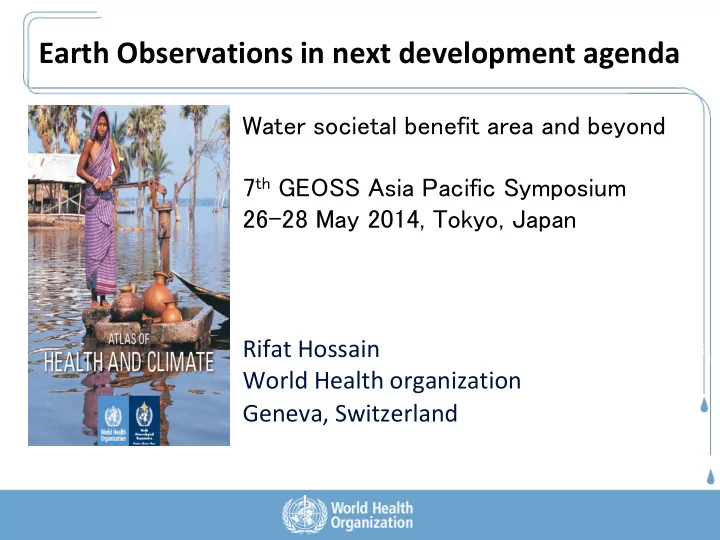

Earth Observations in next development agenda Water societal benefit area and beyond 7 th GEOSS Asia Pacific Symposium 26-28 May 2014, Tokyo, Japan Rifat Hossain World Health organization Geneva, Switzerland
Water related diseases, a leading cause • 750M without potable water • Billions without safe water Nearly • 2.5B without san 700,000 • 1.0B Open deaths defecation annually • Worse under CC/CV • Waste water pollution? • Water scarcity? http://www.who.int/mediacentre/factsheets/fs310/en/index.htm l
MDG target + Indicators Targe get 7.A: Integrate the principles of sustainable development into country policies and programmes and reverse the loss of environmental resources 7.5 Proportion of total water resources used get 7c: Halve, by 2015, the proportion of people without Targe sustainable access to safe e drink inking ing wa water er and basic sanitation Indi dicato tor to to mon onito tor (pr prox oxy for or access to to safe dr drinking-water er): 7.8/7.9 Proportion of the population that uses an im improved ed drinking-water source/sanitation facility (urban + rural)
Improved versus safe… 100% 100% All water All water 90% 90% infrastructure+surface infrastructure+surface water water 80% 80% All water infrastructure All water infrastructure 70% 70% Improved water sources 60% 60% Improved water sources 50% 50% Safe water sources Safe water sources 40% 40% 30% 30% safe water sources that is within 30mins of home safe water sources that is within 30mins of home 20% 20% safe water sources at home 10% 10% safe water sources at home 0% 0% 1990 2010 1990 2010 Ur Urban Rur ural Improved vs safe at home (2010) U: 93%-45%, R: 44% vs 0.2%
Developments towards post-2015 water sector In In 2010 2010 UN UN ad adopted the Rig ight ht to Dr Drink nking ing-Wat ater an and san anitat ation bring inging ing addit itio iona nal l cr crit iter eria ia o availability, o Sustainability o quality/safety, o non-discrimination, o acceptability, o participation, o accessibility o accountability, o affordability, o impact sustainability. 5
Post-2015 WASH: guiding principles The World needs more ambitious targets and more specific indicators than the Water MDG period • eliminate open defecation; • achieve universal access to basic drinking Sanitation water, sanitation and hygiene for households, schools and health facilities; Hygiene • halve the proportion of the population without access at home to safely managed drinking Equity & water and sanitation services; and Non- Discrim- • progressively eliminate inequalities in access ination 6
Measuring HR to water: using EO INPUT LAYERS: COMBINED OUTPUT LAYERS : (a) Digital Elevation Model (a) Water accessibility: (combination of layers ‘a’ (DEM): Worldwide coverage and ‘d’) Access measured in amount of energy from NASA’s ASTER mission per capita (calories) needed to collect water, with 30-meter resolution. highlighting access limitations due to terrain. Also shows populations living on marginal land (b) (b) Water Resource Map: without water access . Aquifer yield data from multiple sources. Water resources per person: (combination of layers ‘b’ and ‘d’) Determines whether (c) Improved water source location: Location of wells underlying water resources (aquifer yield) can (c) meet demand of overlying population based continually updated with new water projects via interactive on 50 liters per person per day . Web 2.0 application. (d) (d) LandScan Population Areas with improved water access: Database: commercially (combination of layers ‘c’ and ‘d’) available 1-kilometer population Displays 1-km LandScan areas that have database updated yearly achieved water access per guidelines, (http://www.ornl.gov/sci/landscan i.e. at least one access point per 1- /landscan_data_avail.shtml). sq.km
UNSG HLP: WASH, WWM and WRM • Provide universal access to safe drinking water at home, and in schools, health centres, and refugee camps • End open defecation and ensure universal access to sanitation at school and work, and increase access to sanitation at home by x% • Bring freshwater withdrawals in line with supply and increase water efficiency in agriculture by x%, industry by y% and urban areas by z% • Recycle or treat all municipal and industrial wastewater prior to discharge
UN proposal to OWG • Achieve universal access to safe drinking water, sanitation and hygiene • Improve by (x%) the sustainable use and development of water resources in all countries • All countries strengthen equitable, participatory and accountable water governance • Reduce untreated wastewater by X%, nutrient pollution by Y% and increase wastewater reuse by Z% • Reduce mortality by (x%) and economic loss by (y%) from natural and human-induced water- related disasters
WHO-HABITAT-UNEP: GEO a strategic partner EO, novel data & data integration domestic waste WASH water and reuse industrial waste WWM &WQ water and reuse water quality and reuse water withdrawals and productivity water withdrawals WRM and ecosystems 10
UN initiative: SDG on water • A global monitoring project$30-50M – $18M from SDC SDG G on n • Initial phase of 10 years water er • 3 phases WWWQ WWWQ – Frame development: 2014 & WRM RM – Testing/pilot: 2015 – Full project phase: 2016-2023 – Baseline setting and first global report: 2017 • Possible merger with JMP 2018 onwards.
Linking water with climate and health /public nge/p ml html chang ex.ht ndex /globalch n/ind /en/ /report/e nt/g //www.who.int /atlas/r ations/a http:// Cholera outbreaks in areas where WASH coverage is poor, and more likely with higher precipitation anomalies
THANK YOU For more info Rifat HOSSAIN Email: hossainr@who.int
Recommend
More recommend